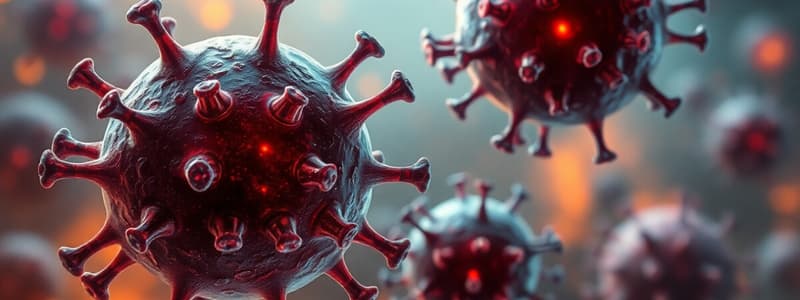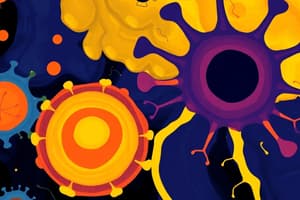Podcast
Questions and Answers
What type of receptors do macrophages utilize to recognize pathogens?
What type of receptors do macrophages utilize to recognize pathogens?
- Pattern recognition receptors (PRRs) (correct)
- Chemokine receptors
- Adaptive immune receptors
- Neurotransmitter receptors
Which of the following correctly describes the mechanism of opsonization?
Which of the following correctly describes the mechanism of opsonization?
- T cells produce antibodies that directly destroy pathogens.
- Natural killer cells are the primary agents in opsonization.
- Opsonization occurs only in the adaptive immune response.
- Pathogens are coated with antibodies or complement to enhance phagocytosis. (correct)
Which of the following receptors is NOT typically involved in the innate immune response?
Which of the following receptors is NOT typically involved in the innate immune response?
- Scavenger receptors
- IgM receptors (correct)
- Toll-like receptors (TLRs)
- Mannose receptors
How do natural killer (NK) cells contribute to the immune response?
How do natural killer (NK) cells contribute to the immune response?
Which of the following is NOT a characteristic of pattern recognition receptors (PRRs)?
Which of the following is NOT a characteristic of pattern recognition receptors (PRRs)?
What is the purpose of the fusion between phagosome and lysosome in phagocytes?
What is the purpose of the fusion between phagosome and lysosome in phagocytes?
Which enzyme is primarily responsible for the oxidative burst during the oxygen-dependent phase of microbial killing?
Which enzyme is primarily responsible for the oxidative burst during the oxygen-dependent phase of microbial killing?
Which of the following is NOT a mechanism by which phagocytes can kill microbes?
Which of the following is NOT a mechanism by which phagocytes can kill microbes?
What is the role of myeloperoxidase in phagocytes?
What is the role of myeloperoxidase in phagocytes?
Which of the following actions is associated with the innate immune response involving macrophages?
Which of the following actions is associated with the innate immune response involving macrophages?
Which component is recognized as a part of the bacterial cell wall by the innate immune system?
Which component is recognized as a part of the bacterial cell wall by the innate immune system?
What function does C-Reactive Protein (CRP) primarily serve in the immune response?
What function does C-Reactive Protein (CRP) primarily serve in the immune response?
Which of the following is NOT categorized under Pattern Recognition Receptors (PRRs)?
Which of the following is NOT categorized under Pattern Recognition Receptors (PRRs)?
Which of the following is a critical mechanism by which the innate immune system enhances phagocytosis?
Which of the following is a critical mechanism by which the innate immune system enhances phagocytosis?
What type of molecular unit is identified as a PAMP from the bacterial cell wall?
What type of molecular unit is identified as a PAMP from the bacterial cell wall?
Study Notes
Receptor Recognition
- Immunoglobulins (Ig) receptors: bind to Fc regions of antibodies.
- Complement receptors: bind to complement proteins (C3) on pathogens.
- Scavenger receptors: bind to various molecules on pathogens.
- Toll-like receptors (TLRs): recognize pathogen-associated molecular patterns (PAMPs).
- Mannose receptors: bind mannose sugars found on some bacterial surfaces.
Opsonization
- Antibodies or complement proteins coat or opsonize pathogens.
- Phagocytes possess receptors that bind to either complement or immunoglobulin Fc regions.
- Opsonization enhances phagocytosis by providing a binding site for phagocytes.
Phagocytosis
- Phagocytes - neutrophils, macrophages, and dendritic cells (DCs) - engulf pathogens.
- Phagosomes form and fuse with lysosomes to create phagolysosomes.
- Phagolysosomes contain enzymes and reactive oxygen species (ROS) to kill pathogens.
Pattern Recognition Receptors (PRRs)
- Phagocytes express PRRs that recognize PAMPs.
- PRRs trigger intracellular signaling pathways to activate immune responses.
- PAMPs are conserved microbial components distinct from host molecules.
Examples of PAMPs
- Peptidoglycan (PG): found in bacterial cell walls.
- Lipopolysaccharide (LPS): found in Gram-negative bacterial cell walls.
- Lipoteichoic acid: found in Gram-positive bacterial cell walls.
- Viral RNA and DNA (CpG): recognized by specific TLRs.
- Microbial phosphocholine: present on some pathogens.
- Microbial protein: often start with formyl-methionine (F-met), distinct from host proteins.
Secreted Pattern Recognition Molecules
- Acute phase response proteins: soluble pattern recognition molecules produced by the liver.
- Mannose-binding lectin (MBL): binds to mannose sugars on microbial surfaces.
- C-reactive protein (CRP): binds to phosphocholine in microbial LPS.
Phagocyte Function - Microbial Killing
- Oxygen independent: hydrolytic enzymes and lysozyme degrade pathogens.
- Oxygen dependent (respiratory burst): uses NADPH oxidase (PHOX) to produce reactive oxygen species (ROS) to kill pathogens.
- Myeloperoxidase: uses hydrogen peroxide to oxidize chloride ions into hypochlorite (ClO-) for antimicrobial activity.
- Defects in ROS production increase susceptibility to bacterial and fungal infections.
Phagocyte Function - Antigen Presentation
- Phagocytes process and present antigens to T cells, to initiate adaptive immune responses.
- Phagocytes release signaling molecules (cytokines) that influence other immune cells.
Studying That Suits You
Use AI to generate personalized quizzes and flashcards to suit your learning preferences.
Related Documents
Description
Test your knowledge of immune system receptors and their roles in pathogen recognition and phagocytosis. This quiz covers immunoglobulins, complement receptors, opsonization, and pattern recognition receptors. Enhance your understanding of how the immune system identifies and responds to pathogens.




